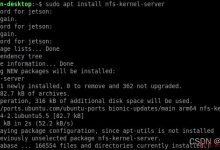Linux系统sersync数据实时同步
前面介绍了以守护进程的方式传输或同步数据rsync软件,linux系统数据同步软件很多,今天来介绍下sersync数据同步软件
一:sersync介绍
sersync其实是利用inotify和rsync两种软件技术来实现数据实时同步功能的,inotify是用于监听sersync所在服务器上的文件变化,结合rsync软件来进行数据同步,将数据实时同步给客户端服务器
二:sersync工作过程
在同步主服务器上开启sersync,负责监听文件系统的变化,然后调用rsync命令把更新的文件同步到目标服务器上,主服务器上安装sersync软件,目标服务器上安装rsync服务
三:整体环境拓扑图

四:客户端安装配置rsync服务
[root@Client ~]# cat /etc/rsyncd.conf
cat: /etc/rsyncd.conf: No such file or directory
如果有此文件,配置前要进行备份,再进行相关配置
[root@Client etc]# vi /etc/rsyncd.conf
##rsync config start
##created by root 2016-08-08 15:00
##rsync.conf config start
uid = rsync
gid = rsync
use chroot = no
max connetctions = 200
timeout = 100
pid file = /var/run/rsyncd.pid
lock file = /var/run/rsync.lock
log file = /var/log/rsyncd.log
[backup]
path = /backup/
ignore errors
read only = false
list = false
hosts allow = 192.168.1.0/24
hosts deny = 0.0.0.0/32
auth users = rsync_backup
secrets file = /etc/rsync.password
##rsync config end
\”rsyncd.conf\” [New] 21L, 458C written
添加用户
[root@Client ~]# useradd rsync -s /sbin/nologin -M
改变目录权限
[root@Client ~]# chown -R rsync.rsync /backup
配置密码文件
[root@Client ~]# echo \”rsync_backup:rsync.conf\”>>/etc/rsync.password
[root@Client ~]# cat /etc/rsync.password
rsync_backup:rsync.conf
改变密码文件权限
[root@Client ~]# chmod 600 /etc/rsync.password
[root@Client ~]# ls -ld /etc/rsync.password
-rw——-. 1 root root 24 Sep 9 13:06 /etc/rsync.password
格式化文件
[root@Client ~]# dos2unix /etc/rsyncd.conf
dos2unix: converting file /etc/rsyncd.conf to UNIX format …
开启服务后台运行
[root@Client ~]# rsync –daemon
[root@Client ~]# netstat -lntup|grep rsync
tcp 0 0 0.0.0.0:873 0.0.0.0:* LISTEN 2002/rsync
tcp 0 0 :::873 :::* LISTEN 2002/rsync
五:主服务器上配置密码文件
[root@Master ~]# echo \”rsync.conf\”>>/etc/rsync.password
[root@Master ~]# cat /etc/rsync.password
rsync.conf
[root@Master ~]# chmod 600 /etc/rsync.password
[root@Master ~]# ls -ld /etc/rsync.password
-rw——-. 1 root root 11 Sep 8 06:25 /etc/rsync.password
六:测试手工同步
[root@Master /]# rsync -avzP /etc/hosts [email protected]::rsync –password-file=/etc/rsync.password
sending incremental file list
hosts
158 100% 0.00kB/s 0:00:00 (xfer#1, to-check=0/1)
sent 120 bytes received 27 bytes 26.73 bytes/sec
total size is 158 speedup is 1.07
[root@Master /]# cat /etc/hosts
127.0.0.1 localhost localhost.localdomain localhost4 localhost4.localdomain4
::1 localhost localhost.localdomain localhost6 localhost6.localdomain6
[root@Client ~]# cat /backup/hosts
127.0.0.1 localhost localhost.localdomain localhost4 localhost4.localdomain4
::1 localhost localhost.localdomain localhost6 localhost6.localdomain6
经过对比两边数据一致,表明同步成功,手工同步成功之后,然后再进行后面的配置
七:安装sersync服务
首先下载好安装软件
sersync_64bit_binary_stable_final.tar.gz
[root@Master tools]# tar -zxvf sersync_64bit_binary_stable_final.tar.gz -C
/usr/local/
GNU-Linux-x86/
GNU-Linux-x86/sersync2
GNU-Linux-x86/confxml.xml
[root@Master tools]# cd /usr/local/
[root@Master local]# ls
bin games include lib64 sbin src
etc GNU-Linux-x86 lib libexec share
GNU-Linux-x86就是sersync安装软件,为了方便将它改名
[root@Master local]# mv GNU-Linux-x86 sersync
为了后续方便管理,创建几个目录用于存放各类文件
[root@Master sersync]# mkdir -p conf bin logs
[root@Master sersync]# mv confxml.xml conf
[root@Master sersync]# ls
bin conf logs sersync2
[root@Master sersync]# cd conf
[root@Master conf]# ls
confxml.xml
在配置配置文件之前备份
[root@Master conf]# cp confxml.xml confxml.xml.$(date +%F)
[root@Master conf]# ls
confxml.xml confxml.xml.2016-09-08
修改配置文件内容(confxml.xml)
1、修改24-28行
<localpath watch=\”/opt/tongbu\”>
<remote ip=\”127.0.0.1\” name=\”tongbu1\”/>
<!–<remote ip=\”192.168.8.39\” name=\”tongbu\”/>–>注释内容
<!–<remote ip=\”192.168.8.40\” name=\”tongbu\”/>–>注释内容
</localpath>
修改后的内容为
<localpath watch=\”/opt/backup\”> 本地数据的路径
<remote ip=\”192.168.1.3\” name=\”rsync\”/>远端IP与模块名称
</localpath>
<!#################################### –>注释内容
2、修改31-34行内容——认证
<commonParams params=\”-artuz\”/>
<auth start=\”false\” users=\”root\” passwordfile=\”/etc/rsync.pas\”/>
<userDefinedPort start=\”false\” port=\”874\”/><!– port=874 –>
<timeout start=\”false\” time=\”100\”/><!– timeout=100 –>
<ssh start=\”false\”/>
修改后的内容为
<commonParams params=\”-aruz\”/>
<auth start=\”true\” users=\”rsync_backup\” passwordfile=\”/etc/rsync.password\”/>
<userDefinedPort start=\”false\” port=\”874\”/><!– port=874 –>
<timeout start=\”true\” time=\”100\”/><!– timeout=100 –>
<ssh start=\”false\”/>
3、修改36-37行
<failLog path=\”/tmp/rsync_fail_log.sh\” timeToExecute=\”60\”/><!–default
every 60mins execute once–>
修改成我们刚刚创建好的logs目录
<failLog path=\”/usr/local/sersync/logs/rsync_fail_log.sh\” timeToExecut
e=\”60\”/><!–default every 60mins execute once–>
修改完成后最终的配置文件如下
[root@Master conf]# cat /usr/local/sersync/conf/confxml.xml
<?xml version=\”1.0\” encoding=\”ISO-8859-1\”?>
<head version=\”2.5\”>
<host hostip=\”localhost\” port=\”8008\”></host>
<debug start=\”false\”/>
<fileSystem xfs=\”false\”/>
<filter start=\”false\”>
<exclude expression=\”(.*)\\.svn\”></exclude>
<exclude expression=\”(.*)\\.gz\”></exclude>
<exclude expression=\”^info/*\”></exclude>
<exclude expression=\”^static/*\”></exclude>
</filter>
<inotify>
<delete start=\”true\”/>
<createFolder start=\”true\”/>
<createFile start=\”false\”/>
<closeWrite start=\”true\”/>
<moveFrom start=\”true\”/>
<moveTo start=\”true\”/>
<attrib start=\”false\”/>
<modify start=\”false\”/>
</inotify>
<sersync>
<localpath watch=\”/opt/backup\”>
<remote ip=\”192.168.1.3\” name=\”rsync\”/>
</localpath>
<!#################################### –>
<rsync>
<commonParams params=\”-aruz\”/>
<auth start=\”true\” users=\”rsync_backup\” passwordfile=\”/etc/rsync.password\”/>
<userDefinedPort start=\”false\” port=\”874\”/><!– port=874 –>
<timeout start=\”true\” time=\”100\”/><!– timeout=100 –>
<ssh start=\”false\”/>
</rsync>
<failLog path=\”/usr/local/sersync/logs/rsync_fail_log.sh\”timeToExecute=\”60\”/><!–default every 60mins execute once–>
<crontab start=\”false\” schedule=\”600\”><!–600mins–>
<crontabfilter start=\”false\”>
<exclude expression=\”*.php\”></exclude>
<exclude expression=\”info/*\”></exclude>
</crontabfilter>
</crontab>
<plugin start=\”false\” name=\”command\”/>
</sersync>
<plugin name=\”command\”>
<param prefix=\”/bin/sh\” suffix=\”\” ignoreError=\”true\”/> <!–prefix /opt/tongbu/mmm.sh suffix–>
<filter start=\”false\”>
<include expression=\”(.*)\\.php\”/>
<include expression=\”(.*)\\.sh\”/>
</filter>
</plugin>
<plugin name=\”socket\”>
<localpath watch=\”/opt/tongbu\”>
<deshost ip=\”192.168.138.20\” port=\”8009\”/>
</localpath>
</plugin>
<plugin name=\”refreshCDN\”>
<localpath watch=\”/data0/htdocs/cms.xoyo.com/site/\”>
<cdninfo domainname=\”ccms.chinacache.com\” port=\”80\” username=\”xxxx\” passwd=\”xxxx\”/>
<sendurl base=\”http://pic.xoyo.com/cms\”/>
<regexurl regex=\”false\” match=\”cms.xoyo.com/site([/a-zA-Z0-9]*).xoyo.com/images\”/>
</localpath>
</plugin>
</head>
八:开启sersync守护进程
首先配置全局环境变量,使得后同可以直接调用sersync命令
[root@Master conf]# echo \’export PATH=$PATH:/usr/local/sersync/bin\’>>/etc/profile
[root@Master conf]# tail -1 /etc/profile
export PATH=$PATH:/usr/local/sersync/bin
[root@Master conf]# source /etc/profile
[root@Master conf]# which sersync
/usr/local/sersync/bin/sersync
启动sersync服务
serync -r -d -o /usr/local/sersync/conf/confxml.xml
-r初始化数据
-d后台启动
-o指定路径
如果需要将命令开启动,只需将命令去掉参数-r定入/etc/rc.local
启动后结果如下
[root@Master backup]# sersync -r -d -o /usr/local/sersync/conf/confxml.xml
set the system param
execute:echo 50000000 > /proc/sys/fs/inotify/max_user_watches
execute:echo 327679 > /proc/sys/fs/inotify/max_queued_events
parse the command param
option: -r rsync all the local files to the remote servers before the sersync work
option: -d run as a daemon
option: -o config xml name: /usr/local/sersync/conf/confxml.xml
daemon thread num: 10
parse xml config file
host ip : localhost host port: 8008
daemon start,sersync run behind the console
use rsync password-file :
user is rsync_backup
passwordfile is /etc/rsync.password
config xml parse success
please set /etc/rsyncd.conf max connections=0 Manually
sersync working thread 12 = 1(primary thread) + 1(fail retry thread) + 10(daemon sub threads)
Max threads numbers is: 22 = 12(Thread pool nums) + 10(Sub threads)
please according your cpu ,use -n param to adjust the cpu rate
——————————————
rsync the directory recursivly to the remote servers once
working please wait…
executecommand: cd /opt/backup && rsync -aruz -R –delete ./ –timeout=100 [email protected]::rsync–password-file=/etc/rsync.password >/dev/null 2>&1
run the sersync:
watch path is: /opt/backup
九:测试数据同步
[root@Master sersync]# cd /opt/backup/
[root@Master backup]# ls
[root@Master backup]# ls -ll
total 0
[root@Master backup]# touch 123
[root@Master backup]# touch 1234
[root@Master backup]# touch 1235
[root@Master backup]# touch 12333
[root@Master backup]# ls -ll
total 0
-rw-r–r–. 1 root root 0 Sep 8 09:26 123
-rw-r–r–. 1 root root 0 Sep 8 09:26 12333
-rw-r–r–. 1 root root 0 Sep 8 09:26 1234
-rw-r–r–. 1 root root 0 Sep 8 09:26 1235
目标服务器查看同步情况
[root@Client backup]# ls -ll
total 0
-rw-r–r–. 1 rsync rsync 0 Sep 8 04:26 123
-rw-r–r–. 1 rsync rsync 0 Sep 8 04:26 12333
-rw-r–r–. 1 rsync rsync 0 Sep 8 04:26 1234
-rw-r–r–. 1 rsync rsync 0 Sep 8 04:26 1235
测试结果表明数据同步正常,能够实时同步
 爱站程序员基地
爱站程序员基地


